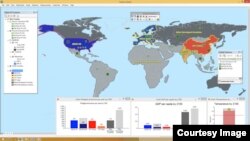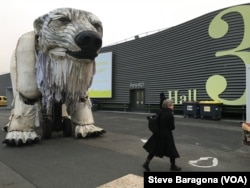While negotiators in Paris wrangle over who will cut their carbon emissions and by how much, the rest of us may soon be able to play along at home with the Carbon Game.
In this video board game under development by Dutch researchers, players have to cut their greenhouse gas emissions in order to keep the Earth under 2 degrees of warming. But every cut has consequences for the player’s economy.
No player can reach the 2 degree target by him or herself. And no player wants to take the entire hit. It takes negotiations to get everyone around the board to agree on how they’ll get there.
Researcher Linda Carton and her colleagues at Radboud University wanted to make the complicated challenges and tradeoffs facing climate negotiators clearer to the rest of us.
A simple assignment
The game divides the world into six parts. One player represents each of the top emitters: China, the United States, Europe or India. The rest of the world is divided into two blocs: developed and developing countries. Each player chooses a bloc and starts the game with coins representing its projected cumulative greenhouse gas emissions through 2100.
“It’s a simple assignment,” Carton said. “Try to limit your emissions to 2 degrees.” That means ending the round with fewer than 1,000 gigatons of carbon on the table.
Here’s where it gets tricky. China alone starts the game with 2,000 gigatons.
“So then we say, ‘Well, let’s negotiate. It’s your floor now. Who starts leading the world toward a low carbon future?’”
Players do so at their own peril. Lowering carbon emissions lowers their GDP per capita as well.
You’ll often hear players saying, “‘It’s not my turn, let somebody else do the hard part,’” she said. “They hope in the end they can do a little bit of free riding.”
But the other players notice. “Then everybody blames and shames you, that you are the free rider of the game.”
Shared sacrifice
Cuts hurt some players worse than others, depending on how carbon intensive their economies are. At one game played here at the Paris climate summit, Carton said, “The woman who played India made a big pledge. And then she saw what it did to the GDP per capita. And she said, ‘Oh no! Put it back! Put it back! My people cannot take this!’”
In the end, “we sacrificed the Indian economy and all the people living there, but we saved the world,” she said.
“The lesson is that it’s a long way down from 4.5 degrees,” the current trajectory, “to 2 degrees,” she said, “and we all need to look at each other and say, ‘It’s your turn.’”
Round two
The researchers are working on adding two more rounds. In round two, players haggle over who will give up their fossil fuel reserves. The third round is a bit cheerier. Players get to invest in renewable energy.
“You’ll see in the end that you not only saved the world in temperature, but you also built your own green economy,” Carton said.
But even that doesn’t come easy. When you build wind parks and smart grids, “the costs are all upfront.”
The game is still under development. It’s a side project Carton and her colleagues do in their spare time. Carton hopes to turn it into a smart phone app, and a teaching tool for her students.
“I want to educate them about the magnitude of the task that’s ahead of them for their generation,” she said. “You have to reduce emissions by 80 percent worldwide. That’s not a small thing.”











